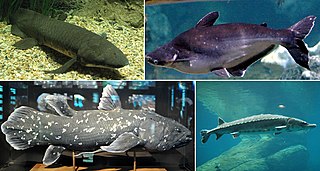
Osteichthyes, commonly referred to as the bony fish, is a diverse superclass of vertebrate animals that have skeletons primarily composed of bone tissue. They can be contrasted with the Chondrichthyes, which have skeletons primarily composed of cartilage. The vast majority of extant fish are members of Osteichthyes, which is an extremely diverse and abundant group consisting of 45 orders, over 435 families and 28,000 species. It is the largest class of vertebrates in existence today.
Lampriformes is an order of ray-finned fish. Members are collectively called lamprids or lampriforms, and unite such open-ocean and partially deep-sea Teleostei as the crestfishes, oarfish, opahs, and ribbonfishes. A synonym for this order is Allotriognathi, while an often-seen, but apparently incorrect, spelling variant is Lampridiformes. They contain seven extant families which are generally small but highly distinct, and a mere 12 lampriform genera with some 20 species altogether are recognized.

Opahs, also commonly known as moonfish, sunfish, kingfish, and redfin ocean pan are large, colorful, deep-bodied pelagic lampriform fishes comprising the small family Lampridae.

Squalodon is an extinct genus of whales of the Oligocene and Miocene epochs, belonging to the family Squalodontidae. Named by Jean-Pierre Sylvestre de Grateloup in 1840, it was originally believed to be an iguanodontid dinosaur but has since been reclassified. The name Squalodon comes from Squalus, a genus of shark. As a result, its name means "shark tooth". Its closest modern relative is the South Asian river dolphin.

Prosqualodon is an extinct genus of Early to Middle Miocene cetacean from Argentina, Australia, New Zealand and Venezuela.
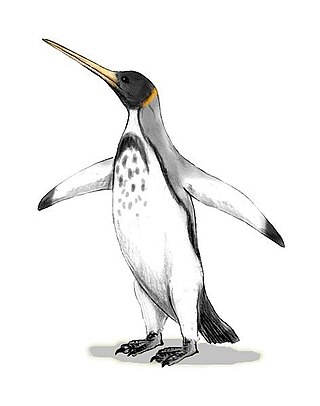
Icadyptes is an extinct genus of giant penguins from the Late Eocene tropics of South America.

Otodus angustidens is a species of prehistoric megatoothed sharks in the genus Otodus, which lived during the Oligocene and Miocene epochs about 33 to 22 million years ago. The largest individuals were about 11–12 metres (36–39 ft) long. This shark is related to another extinct megatoothed shark, Otodus megalodon.
Kaiwhekea is an extinct genus of plesiosaur from the Late Cretaceous of what is now New Zealand.
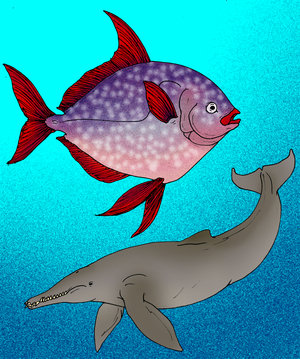
Waipatia is an extinct genus of dolphin from the late Oligocene (Chattian) of New Zealand.
Simocetus is an extinct genus of toothed whale that lived during the Oligocene period, approximately 32 million years ago, making it the oldest named toothed whale, although older unnamed toothed whales exist.
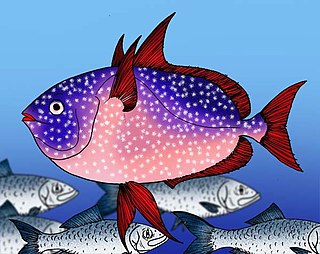
Lampris zatima is the oldest known opah of the genus Lampris, from the Late Miocene of Southern California. Its fossil record is rather poor, known primarily from isolated vertebral columns, and a few headless specimens. Alive, it is estimated to have been around 20 to 30 centimeters long.

Kairuku is an extinct genus of penguin. It contains three species, K. grebneffi, K. waitaki and K. waewaeroa. This taxon is known from bones from 27 MYA, from the Kokoamu Greensand Formation of New Zealand. It was historically referred to as Palaeeudyptes.
The Kokoamu Greensand is a geological formation found in New Zealand. It is a fossil-bearing, late Oligocene, greensand rock unit of the eastern South Island, especially the Waitaki District of North Otago and the southern Canterbury region. The formation was named by geologist Maxwell Gage in the 1950s. In North Otago it underlies the thicker and harder Otekaike Limestone. The formation gets its green colour from the mineral glauconite which forms slowly on the ocean floor.

Llanocetus is a genus of extinct toothed baleen whales from the Late Eocene of Antarctica. The type species, Llanocetus denticrenatus, reached gigantic proportions, with the juvenile specimen reaching an estimated 8 m (26 ft) in length; a second, unnamed species, known only from three isolated premolar teeth, reached an estimated total body length of up to 12 m (39 ft). Like other contemporary baleen whales of the Eocene, Llanocetus completely lacked baleen in its jaws. It was probably a suction feeder like the modern beaked and pygmy right whales.

Otekaikea is an extinct genus of toothed whale closely related to Waipatia. It is known from the late Oligocene (Chattian) of New Zealand.
Mauicetus is a genus of extinct baleen whale from the Late Oligocene of New Zealand.
Tohoraata is a genus of eomysticetid baleen whale from the Late Oligocene (Chattian) of New Zealand. There are two recognized species, T. raekohao and T. waitakiensis.
Lampris immaculatus, commonly known as the southern opah or southern moonfish, is a species of fish native to the Southern Ocean. The species is found commonly in New Zealand waters. They are caught commercially using long-line fishery in New Zealand. The most common prey species for the southern opah are juvenile onychoteuthid squid Moroteuthis ingens, which were found in 93% of 69 fish. It was discovered that 14% of the opahs contained plastic pollutants in their digestive tract, which indicates signs of high plastic pollution in the Southwest Atlantic.

Kumimanu is an extinct genus of giant penguin, which lived around 60 to 56 million years ago. The type species is K. biceae, which arose after the extinction of the non-avian dinosaurs. Fossils were found in New Zealand, and the discovery was announced in December 2017. A second species, Kumimanu fordycei, was named in February 2023.
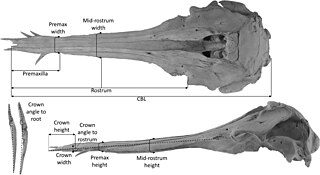
Nihoroa is an extinct genus of waipatiid odontocete cetacean from the glauconitic Otekaike Limestone in North Otago; New Zealand. The type species is N. reimaea, known from only the holotype which comprises various skull elements.













